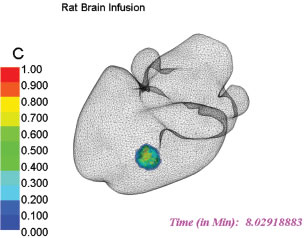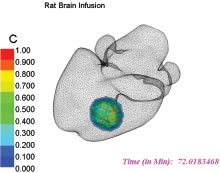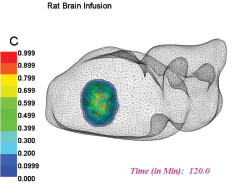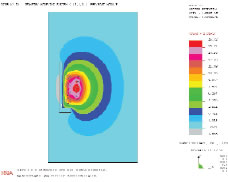Latest News
January 11, 2008
By Pamela J. Waterman
Part 1 of this two-part featurelooking at multiphysics explored several state-of-the-art appplications incorporating two or more types of physical analysis.
 Analytic & Computational Research, Inc. (ACRi)‘s PORFLOW is used here to analyze the flow of a drug through the brain of a rat. Originally designed to model fluid convection and diffusion in rigid porous media such as rock and soil, the software is used here to model dynamically coupled flow and mass transport through gray and white brain matter, which have different material properties. (images courtesy of ACRi) |
Solving real-world problems often dictates the use of analysis software that handles more than one type of physics. This is imperative when the effects of coupling between different physical fields shouldn’t be ignored. Resolving these intricacies — thermal-structural, magnetic-structural, electrostatic-structural, piezoelectric, fluid-structural, and electromagnetic-heat transfer — poses a true challenge, but ever-evolving software developments are up to the task.
Here, DE takes another look at companies improving their design understanding by incorporating two or more analysis types with electrical and medical applications. We also explore the resources available from NAFEMS, the international association for the engineering analysis community.
Indirect Heating Coil Design
High-frequency electric current flowing through a metal coil creates an alternating magnetic flux field. This flux stimulates a heating effect in an object placed in the center of the resulting field. Termed “induction coils,” such structures perform the useful task of indirect heating, but their successful design depends on understanding the effects of many parameters.
 |  |
| These two images show the same ACRi PORFLOW analysis of the rat brain from the previous page but at different time steps, showing the concentration contours of the chemical under study as it migrates through the brain’s tissue at 72 minutes and two hours. (images courtesy of ACRi) | |
The physical properties of the system — thermal conductivity, electrical resistivity, specific heat, density, and magnetic permeability — are all temperature-dependent, making such analysis problems non-trivial and introducing nonlinearity issues in simulations. However, the temperature that is produced is due to the electromagnetic inductance, which itself then changes with the new value of temperature. Thus, designers of induction coils need to iteratively solve a temperature-dependent electrical field and an inductance-introduced heat field to arrive at a solution.
NISA software from Cranes Software allows users to set up an induction-coil model in its EMAG software using an axi-symmetric element. A typical example examines the interactions of a current in a copper coil that wraps around and heats a steel tube, all surrounded by air. The primary task is to solve the magnetodynamic equations coupled to those of thermal heat transfer. EMAG takes the effects of all three different materials into account, and solves the resulting equations iteratively. First, the software solves the magnetodynamic equations for a given temperature distribution and calculates the power density. It then uses this power as the heating source for the thermal calculations, which changes the temperature distribution, in turn changing the physical properties for the next round of magnetodynamics.
 |  |
| These two images are of the same induction heating coil. At left is a NISA contour plot of coupled electromagnetic and heat transfer analysis vector potential. At right is a NISA software finite element model. (images courtesy Cranes Software) | |
NISA EMAG outputs include color plots of flux densities, temperature distribution, stored electric energy, and magnetic vector potential.
Analyzing Fluid Drug-Delivery Machanisms
In the medical world, not all treatments come in pill form. Often a critical drug must be delivered directly into the source of the problem, but natural diffusion may take place too slowly for effective drug distribution. One promising approach being investigated for this problem is called convection enhanced delivery (CED).
Multiphysics: A Question of Fundamental Approach Multiphysics analyses can be performed in two basic ways: direct-coupled and iterative-coupled, and different companies take one or both approaches depending on the specific tasks at hand. Cranes Software, developer of the NISA family of analysis products, makes these distinctions: Direct-Coupled Analysis: In this analysis, the finite element formulation itself takes the multiphysics into account. The advantage of this method is that both the fields are solved together and the solution is obtained in one shot. An example of this is a piezoelectric analysis in which the stress and the electrical fields are coupled at the element formulation level. NISA supports a direct piezoelectric element for such analysis. Iterative-Coupled Physics: For this approach the element formulations are completely independent and hence the equations are solved independently. However the effect of one physics on the other is transferred interactively after each step. At least two iterations, one for each field, are required to get acceptable results. One such coupling that NISA supports is electrical to thermal coupling, a problem associated with inductive heating.—PW |
In this method, drugs are infused using one or more special catheters that deliver the drug while maintaining a pressure gradient (convection) over one or more days. This technique allows the delivery of large molecules such as antibodies or immunotoxins as a bulk flow over a predetermined volume of distribution.
Unfortunately, this task might take place under less than ideal patient conditions. In the case of brain injuries such as an ischemic (clogged blood vessel) stroke, the brain’s microstructure has been altered by cellular swelling and the condition decreases the fractional volume of available extracellular space where the drug would be diffusing.
Peter Haar, a researcher at Virginia CommonwealthUniversity, knows that for CED to be safe and effective, a physician must have accurate knowledge of how concentration distributions will be affected by catheter location, flow rate, patient anatomy, and other parameters. To investigate the accuracy of a proposed predictive model, Haar and his team conducted a study of infusion and diffusion of a drug (chemical species) in a rat brain (a porous medium).
Using MRI images of rat-brain geometry, Haar’s team constructed a 3D triangulated surface as the basis for computed infusion models. They then worked with PORFLOW, a simulation package from Analytic & Computational Research, Inc. (ACRi) originally designed to model fluid convection and diffusion in rigid porous media such as rock and soil for pollutant transport analysis. Here, the software was used to analyze the flow of a drug through the brain.
“Gray” and “white” matter in the brain have different material properties, so the model had to account for these differences while modeling dynamically coupled flow and mass transport. PORFLOW was able to handle anisotropic properties for each element over complex, irregular geometry, using a hybrid between finite element and finite difference methods.
When compared to experimental data, the PORFLOW simulation results predicted concentration distributions following CED with an accuracy of 85 percent.
Multiphysics Resources Through NAFEMS
Sorting out the ever-changing options in multiphysics software and mathematical approaches requires users to stay current with the offerings and accomplishments of a great many software development companies. One way to do so is to tap into the knowledge at NAFEMS, headquartered in Glasgow, Scotland.
The Amazing ElectroElastic Actuator A truly nonlinear class of materials with useful mechanical properties is that of electroactive polymers; one specific application that transforms electrical energy into mechanical work is a dielectric elastomer actuator (DEA). The basic design of a DEA device is a section of elastomeric film coated on both sides with electrode material, with the latter connected to a circuit. When a voltage is applied, Maxwell electrostatic pressure creates a mechanical compression; the elastomer film then contracts in the thickness direction and expands in the film plane. Short-circuiting the electrodes returns the geometry of the device to its starting position. A current application is Braille pads, while the devices may also be useful in the MEMS world due to their low activation voltage. Analyzing DEA behavior requires multiphysics software that can handle both the electrical and mechanical conditions. At a recent NAFEMS webinar, Stephen Scampoli of ANSYS explained how his company’s software modeled a folded DEA and calculated the electroelastic results. The images show (clockwise from top left) a section of the undeformed geometry of the unfolded actuator, the FE model, the mechanical stresses, and the equivalent electrical potential. —PW
|
NAFEMS is an international organization, now with a strong North American regional community, that offers conferences, webinars, publications, and forums for exchanging current information and concerns about the use of computational analysis software. The group notes that in today’s design environment, engineers and designers who are neither specialists nor experts in analysis can greatly benefit from general information about common (and complicated) analysis issues.
At NAFEMS.org, visitors will find a range of resources. The section called Analysis Terms A-Z offers a searchable database of common definitions of terms used for structural finite element analysis and computational fluid dynamics, such as “coefficient of viscous damping” and “simultaneous vector iteration.” Under Knowledge Base is a series of articles that have run in NAFEM’s Benchmark magazine since October 2003; topics include Fundamentals of Numerical Techniques for Static, Dynamic and Transient Analyses and Nominal and Nonlinear Stresses.
For purchase (at very reasonable member and non-member pricing), the website features more than 200 publications from brochures to books on a wide range of topics including nonlinear analysis, fracture mechanics, and benchmark tests.
Specific to multiphysics, NAFEMS has led a number of efforts starting with a program called FENet begun in 2001 and aimed at coordinating activities in the European industrial finite element analysis community. Funded by the European Commission, the goal of the four-year FENet activity was to improve the quality of industrial applications and the level of confidence that can be placed in the computed results.
In its very informative final Multiphysics Analysis report, the FENet group’s co-chairs, Mark Cross and Avril Slone of the University of Wales Swansea, provided a concise description of multi-physics capabilities: “Most CAE software vendors claim multiphysics capabilities, but in reality, what most of them offer at the present time ]2005], is multi-disciplinarity, i.e. data generated by one code issued as input into another, either as boundary data or as a volume source, where the data transfer is one way.
“This is distinguishable from full multiphysics analysis, which involves the two-way exchange of information, which could involve implicit convergence within a time-step. There is also an additional level of sophistication with regard to multiphysics, i.e., closely coupled multiphysics. This type of analysis adds ... complexity since both time- and space-accurate exchange of data is required.” Visit nafems.org/projects/fenet/technology/mpa/ for full results.
Interest in multiphysics within NAFEMS is such that the organization has formed a Multiphysics Technical Group, with Slone as its chair, and more current software product information is being compiled. Recent activities have included the presentation of two webinars attracting more than 600 attendees each. These can be viewed and downloaded as PDF files free of charge at nafems.org/events/webinars/. More such webinars are planned, and in late 2008 in Norfolk,VA, NAFEMS will be hosting a North American regional conference, including multiphysics presentations.
More Info:
Analytic & Computational Research, Inc. (ACRi)
Bel Air, CA
acricfd.com
Cranes Software (formerly NISA Software)
Troy, MI
nisasoftware.com
NAFEMS North America
Monroe, NC
nafems.org
Contributing Editor Pamela J. Waterman is an electrical engineer and freelance technical writer based in Arizona. You can contact her about this article via e-mail sent to [email protected].
Subscribe to our FREE magazine, FREE email newsletters or both!
Latest News
About the Author
Pamela Waterman worked as Digital Engineering’s contributing editor for two decades. Contact her via .(JavaScript must be enabled to view this email address).
Follow DE









